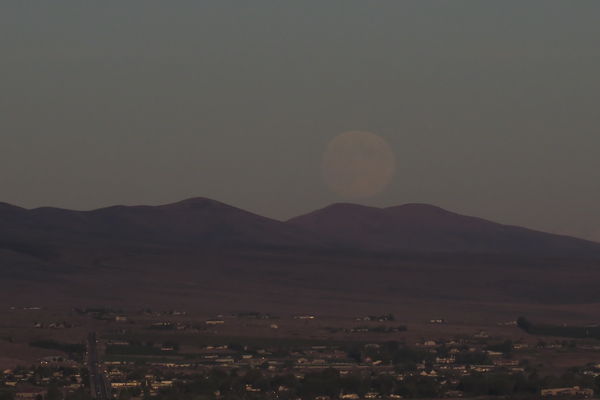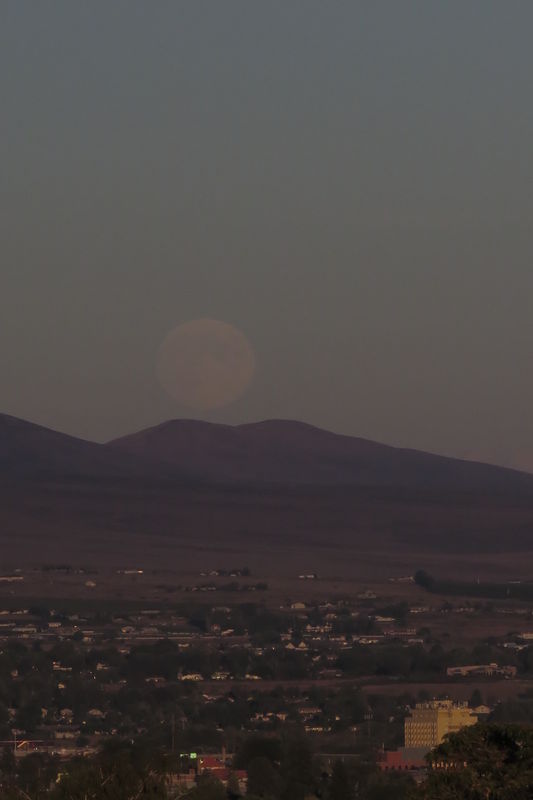something went very wrong with my moonrise shots!
Sep 18, 2013 22:46:11 #
Did I seriously under-expose? Moon wasn't very bright because sun hadn't set yet, so I was using some exposure compensation. I thought I checked LCD a couple of times and don't recall the shots looking this bad!
Thanks for any guidance and/or fixes :) The moon was so huge and gorgeous.
Thanks for any guidance and/or fixes :) The moon was so huge and gorgeous.


Sep 18, 2013 23:07:03 #
Linda From Maine wrote:
Did I seriously under-expose? Moon wasn't very bright because sun hadn't set yet, so I was using some exposure compensation. I thought I checked LCD a couple of times and don't recall the shots looking this bad!
Thanks for any guidance and/or fixes :) The moon was so huge and gorgeous.
Thanks for any guidance and/or fixes :) The moon was so huge and gorgeous.
I would recommend an exposure of 1/250 at f/16. This is based on your ISO setting of 320.
--Bob
Sep 18, 2013 23:18:27 #
rmalarz wrote:
I would recommend an exposure of 1/250 at f/16. This is based on your ISO setting of 320.
--Bob
--Bob
Thank you Bob. I'm hoping I'll get a do-over tomorrow night + moon rises 1/2 hour later so it should be more visible.
Sep 19, 2013 02:34:54 #
Photographing the moon cresting the horizon will always have poor resolution because you are shooting through miles & miles of atmosphere. And if your general area has had any forest fire smoke blown into it, the distortion will be worse.
Shooting the moon at its apex (highest point in night sky) will be the sharpest because of the thinner atmosphere looking straight up than at the horizon. Many dramatic 'Cresting Moon' photos are actually a combination of an overhead full moon merged with a selected horizon.
When shooting a full moon near-directly overhead, remember it is noon on the moon. That means exposure = shutter duration of 1/ISO at f/16, or equivalent.
Shooting the moon at its apex (highest point in night sky) will be the sharpest because of the thinner atmosphere looking straight up than at the horizon. Many dramatic 'Cresting Moon' photos are actually a combination of an overhead full moon merged with a selected horizon.
When shooting a full moon near-directly overhead, remember it is noon on the moon. That means exposure = shutter duration of 1/ISO at f/16, or equivalent.
Sep 19, 2013 05:46:09 #
Nikonian72 wrote:
Photographing the moon cresting the horizon will a... (show quote)
:D
The perfect answer!
Sep 19, 2013 06:59:03 #
Linda From Maine wrote:
Did I seriously under-expose? Moon wasn't very bright because sun hadn't set yet, so I was using some exposure compensation. I thought I checked LCD a couple of times and don't recall the shots looking this bad!
Thanks for any guidance and/or fixes :) The moon was so huge and gorgeous.
Thanks for any guidance and/or fixes :) The moon was so huge and gorgeous.
Just pretend it's a big bright bird. :lol:
Sep 19, 2013 07:23:05 #
alf85
Loc: Northumberland, UK.
For a Canon = ISO 100, SS 1/125, F11.
For a Nikon = ISO 200, SS 1/250, F11.
and adjust from there.
For a Nikon = ISO 200, SS 1/250, F11.
and adjust from there.
Sep 19, 2013 09:16:49 #
Linda From Maine wrote:
Did I seriously under-expose? Moon wasn't very bright because sun hadn't set yet, so I was using some exposure compensation. I thought I checked LCD a couple of times and don't recall the shots looking this bad!
Thanks for any guidance and/or fixes :) The moon was so huge and gorgeous.
Thanks for any guidance and/or fixes :) The moon was so huge and gorgeous.
Your problem is you go out one time and expect to get perfect photographs with something you have never done before.
You also do not say how you took the photos. Camera settings. There is no need for exposure compensation. You probably use camera priority, which is wrong. Learn how to use manual. Shoot in RAW. Practice.
Sep 19, 2013 09:32:18 #
Linda From Maine wrote:
Did I seriously under-expose? Moon wasn't very bright because sun hadn't set yet, so I was using some exposure compensation. I thought I checked LCD a couple of times and don't recall the shots looking this bad!
Thanks for any guidance and/or fixes :) The moon was so huge and gorgeous.
Thanks for any guidance and/or fixes :) The moon was so huge and gorgeous.
You went the wrong way with your EV. EXIF shows a minus setting. You should be on the plus side of EV to brighten image.
Sep 19, 2013 10:47:42 #
Nikonian72 wrote:
Photographing the moon cresting the horizon will a... (show quote)
Thanks for your time and comments, Nikonian. I've been able to get some nice shots of the moon after dark that were well exposed - thanks to previous threads here on UHH.
I have taken some moon rise (a couple posted last month) and moon set shots that came out better than these, so there's some hope :)
Sep 19, 2013 10:47:56 #
RicknJude wrote:
Just pretend it's a big bright bird. :lol:
:thumbup:
Sep 19, 2013 10:48:12 #
alf85 wrote:
For a Canon = ISO 100, SS 1/125, F11.
For a Nikon = ISO 200, SS 1/250, F11.
and adjust from there.
For a Nikon = ISO 200, SS 1/250, F11.
and adjust from there.
Thanks!
Sep 19, 2013 10:50:56 #
cthahn wrote:
Your problem is you go out one time and expect to get perfect photographs with something you have never done before.
You also do not say how you took the photos. Camera settings. There is no need for exposure compensation. You probably use camera priority, which is wrong. Learn how to use manual. Shoot in RAW. Practice.
You also do not say how you took the photos. Camera settings. There is no need for exposure compensation. You probably use camera priority, which is wrong. Learn how to use manual. Shoot in RAW. Practice.
I've actually shot moonrises and moonsets several times. Got some decent ones last month. The link is below. Sorry I didn't specify exif data, though it's available if you download.
http://www.uglyhedgehog.com/t-141866-1.html
Sep 19, 2013 10:52:00 #
naturepics43 wrote:
You went the wrong way with your EV. EXIF shows a minus setting. You should be on the plus side of EV to brighten image.
Thanks naturepics. I was afraid I'd lose the light/white moon if went brighter, but you're right in that at least I should have tried that!
Sep 19, 2013 10:53:27 #
When you check the LCD screen when it is dark, it will appear much brighter, you have to compensate for this. Bracket, I always do and usua;;y wil have an exposure which works.
If you want to reply, then register here. Registration is free and your account is created instantly, so you can post right away.





